Genre: Shmup Developer: Hot-B Publisher: Sage’s Creation Players: 1 Released: 1990
In the earlier days of the Genesis, Sage’s Creation was basically the whipping boy for Genesis owners. Not much has changed really, as the name alone usually induces laughter at the thought of games like Shadow Blasters and Ka-Ge-Ki: Fists of Steel. But invariably, the name Insector X comes up with the words, “but what about…” in front of it. Released in 1990 near the beginning of the Genesis’ shmup deluge, Insector-X is a shmup based off of the Taito arcade game of the same name. It got a fair amount of advertising upon its release, yet never became a hit in any real sense of the word. The question is, did this game pack a powerful wasp- like sting, or was it more like an annoying gnat? Read on.
Unbeknownst to the humans of Earth, there is a war being waged that could affect them… a small-scale war that may have dire consequences if left unchecked. A tribe of insects called the Belzers are on the march. Balgon-Belzeid, their leader, has already wiped out all but one of the peace-loving tribe of insects called the Insectors, and now has his sights set on conquering the human world. You are Kait, the last survivor of the Insectors. You owe that survival to a human boy who found you when you fled into the desert where the Belzer forces had yet to reach. That boy gave you shelter and protection, but now his life is in danger as the Belzers’ march continues into where you’d found a moment of peace. Hiding is no longer an option, so you chose to fight to avenge your fallen people, and to return the protection given to you by that small boy.
For those expecting the cutesy, big eyed, cartoony graphics of the original Taito arcade game, I’ll give you a moment to brace yourselves. Those graphics are long gone. In their place, are more realistic renditions of the mechanized insect army that’s trying to wreak havoc on everything. Moths, grasshoppers, wasps, bees, ants… they all look a lot more like their real-world counterparts now. And to Taito’s credit, they did a pretty good job with the transition. Even the tiny bugs have some nice details in them, and the bigger bosses are the same way. Some good shading helps this along, and the result is a graphical makeover that gives the game a whole different feel. Sadly, the animation’s pretty barren at times on some of the bigger bugs, and there are moments where things look rather odd (like the grasshopper that jumps into the air, yet its legs keep animating like they did when it was running along the ground). But overall, the new look for the characters comes off well.
The backgrounds, oddly enough, are very similar to their arcade counterparts. The city, the jungle, the beehive… they all strongly echo their source, with some changes thrown in at times (like the Egyptian hieroglyphs before you reach the first boss) and a lower, somewhat duller color count used in ares. The levels you fight in are much like the redone character graphics, with some fairly good details and shading. They also have two or more sections to most of them (one outside, one inside… another trait from the arcade original), providing more visual diversity. Unfortunately, the backgrounds are also very flat. There’s no parallax at all, which is a shame considering how some of the levels just look absolutely prime for three or four layers of it. Granted, the arcade game didn’t have any either, but given the changes made to the graphics, the programmers could have gone that extra step and given the levels more depth.
The arcade version’s music, like the graphics, basically went away with the Genesis version. Gone are the happy tunes that reflected the cutesy nature of the arcade game, and in their place reside songs that are more fitting of the serious nature of the revamped graphics. Using some interesting instruments that go with the more unorthodox scenario this game presents, the songs generally range from being catchy (“Tropic Gym”), Jazzy (“Groove Diver”) and even moody (“Damp Hall”), with all of them coming off sounding good overall. They also make for a slightly laid-back soundtrack to go along with the game’s not-quite-hectic action. As those tunes play, the sound effects you’ll be hearing go with the insect nature of the game. While they won’t floor you quality-wise, they’re used well and are plentiful enough to give the game a fitting set of varied sounds to go with the onscreen action.
As mentioned before, Insector X is a shmup. As such, its gameplay is firmly tied to what one would expect for the genre. You fight your way through a series of stages, battling airborne and ground-based enemies. You’ll collect powerups for both your gun, and a secondary weapon that’ll help battle the many bugs trying to stop you. On top of that, the secondary weapon has two modes… an air attack, and a ground attack, which you can switch between at will. There’s also a bomb weapon that occasionally pops up, which kills the small weaker enemies on the screen. All these will be used as you fight your way through the aforementioned more relaxed pacing of the game. That’s not to say that the game’s boring mind you, it’s simply not as fast paced and hectic as other Genesis shmups, giving you plenty of time to react more often than not. And of course, at the end of each stage, you’ll fight a big boss bug that’s tougher to kill with heavier firepower at their disposal.
Of note in this game is how it tries to keep up with you as you power up your fighter. Once you reach a certain power level, the small so-called “popcorn” enemies that you destroy turn into a single bullet that comes at the spot you were sitting at when you destroyed that little enemy. And as you get farther into the game, those bullets become faster, making for a greater challenge. You’ll also find that some enemies seem to stay on par with your power level, in that it takes basically just as long to kill them powered up as it does when your power level is lowest. While this may seem unfair in some ways, it does keep the game from becoming a complete push over, given that you can acquire some substantial firepower.
So here we are, the section that a Sage’s Creation game dreads… the “what’s wrong with it?” portion. But really, there aren’t any glaring faults to be found… save for one. It doesn’t visually make the best use of the hardware it’s on. The graphics are noticeably grainy in spots, the colors used on the backgrounds feel very dull or bland half the time, and as stated before, the painfully flat backgrounds really didn’t have to be. This game may have come out in 1990, but it falls a bit behind even by the standards of the time… despite the work Taito obviously put into redoing the visuals. As such, this is the game’s main crutch.
On the more minor side of things, this game’s difficulty isn’t that menacing. It’s not quite a “cake walk,” but you can finish it on Normal without much trouble or having to continue. The stages are tougher than the bosses, as despite that they can take a fair number of hits to kill, the boss pattern s aren’t complicated at all. Couple that with a big drop in difficulty when you die, and the game’s just a bit too easy. One last thing about the game is that it’s also somewhat short. With only five levels, it goes by in just under twenty minutes, which is a shame. The original arcade game was the same length, which is fine for quarter-munching arcade games, but the length hurts it a bit on the console front.
So how does Insector X stack up? Well, “solid” comes to mind, as that’s basically what the game is. A solid representation of the genre it’s a part of. The visuals are still pretty good as a whole despite the flat stages and dull-colored backgrounds, the more realistic take was a nice change, the music is done well, the controls and hit detection are good, and the power-up system offers some good variety. Though the gameplay is standard for the most part, and it could have used a difficulty boost, the insect source the game draws from is an interesting one… giving the game a unique trait that wouldn’t really be touched again on the Genesis until Bio-Hazard Battle came out a few years later. It doesn’t stumble, nor does it shine as brightly as other 1990 shmups on Sega’s 16-bit machine. But what it does do is offer up a somewhat flawed, yet enjoyable slice of shmupping, and show that not all the games published by Sage’s Creation were rubbish.
SCORE: 7 out of 10

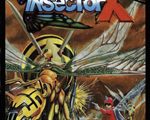
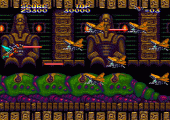
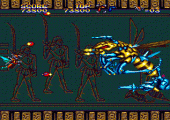
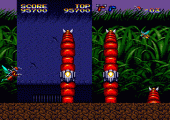
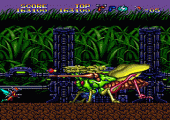
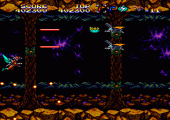
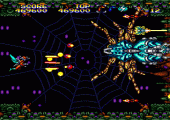
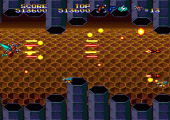
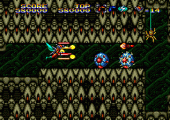
Recent Comments